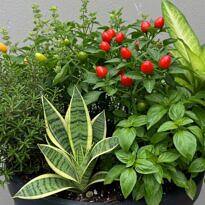Many potted species that have been cultivated for a long time show better development when they are replanted, renewing their vigor. Anthuriums are no exception, and it’s important to know how to repot them. In general, repotting should be done every two years with the goal of renewing the substrate, encouraging new root growth, improving drainage, and providing the plant with better conditions to develop and flourish. In this article, you will learn how to repot your Anthurium and promote healthy growth.

General Care for Anthuriums
Anthuriums, which belong to the Anthurium genus in the Araceae family, are well-known for their ornamental flowers and foliage, making them a popular choice for indoor environments. They are a classic element in landscaping, fitting perfectly in shaded areas, whether in a garden or indoors. This adaptability is due to their origin in the tropical forests of South and Central America, where they primarily grow as epiphytes, protected by the dense canopies of trees.
As a result, they should be grown in filtered light or partial shade, as direct sunlight can scorch their vibrant leaves. They prefer a lightweight substrate rich in organic matter, slightly acidic, and well-draining. Regular watering is necessary to maintain the substrate moist but never waterlogged. The objective is to replicate the environment of the forests, characterized by the accumulation of decomposing leaves and branches.
With their beautiful and colorful inflorescences, Anthuriums capture attention. These inflorescences consist of a modified and colorful leaf called a spathe, and a spadix, which is the elongated column that holds numerous very small true flowers.

When it comes to repotting, Anthuriums need to be relocated every two or three years. Typically, the need for repotting is signaled by roots emerging from the drainage holes of the pot.
When to Repot Anthuriums
As responsible gardeners, it’s important to pay close attention to avoid missing the ideal time for repotting and causing stress to our plants. A common mistake many people make is repotting right after purchasing a plant. However, this is not advisable, as newly purchased plants might have experienced stressful conditions during transportation and acclimatization to their new environment.
Therefore, adding further stress by repotting immediately is not a good idea. Even if the plant seems cramped in its pot, it’s better to wait until it adapts to its new environment and shows signs of growth before considering repotting.
Another crucial point is to avoid repotting a flowering Anthurium. Repotting during the flowering period can shorten the duration of the flowers and weaken the plant, as its energy is primarily directed towards blooming rather than root establishment. The best time to repot Anthuriums is at the beginning of spring.
Signs that Indicate the Need for Repotting Your Anthurium:
- Roots growing out of the drainage holes: This indicates that the plant is still growing, but it has outgrown its current space.
- Leaf spots: If your Anthurium’s leaves are developing spots, it might be a sign of aging and susceptibility to diseases. Repotting can help rejuvenate the plant.
- Excessively long stem: If the stem is overly elongated and leaning, it’s an indication that the plant needs a new support or trellis.
- Small leaves: Nutrient depletion in the current substrate can lead to the development of smaller leaves. Repotting with fresh substrate can provide the plant with the necessary nutrients.
- Poor flowering: If your Anthurium is flowering less than usual or not producing its characteristic beautiful inflorescence, it might be struggling to allocate energy to both flowering and survival in its current pot.
- “Bursting” pot: When the pot becomes visibly deformed due to the growth of the plant’s roots, it’s a clear indication that repotting is necessary. The substrate might start to push against the pot’s edges.
If your Anthurium displays any of these signs and it has been at least a year since the last repotting, it’s time to consider repotting. This will involve transferring the plant to a new pot, refreshing the substrate, and providing a gentle dose of organic fertilizer to support its growth.
How to Repot Anthuriums in 7 Steps:
-
- The first step in repotting your Anthurium is to select a new pot. Choose a pot that provides enough space for growth; a pot that is too large can hinder development, while a pot that is too small will require more frequent repotting. Ideally, the new pot should be proportionate to the plant’s size, allowing about 3cm of extra space on all sides. The material of the pot doesn’t matter, but it should have sufficient drainage holes to prevent waterlogging.

-
- Next, cover the drainage holes of the new pot with a coffee filter or a piece of mesh to prevent the substrate from escaping. When it comes to the substrate, choose a mix that’s suitable for Anthuriums, bromeliads, or orchids. Anthuriums thrive in substrates that offer good drainage and aeration, often composed of fibrous materials. You can even add up to a quarter of organic compost to the substrate mix to enhance its fertility.
- Gently remove the Anthurium from its current pot. It’s best to perform repotting before watering the plant, as moist roots are more flexible and less prone to damage. Carefully untangle any roots that are clinging to the old substrate. Keep in mind that repotting is a stressful process for the plant, so handle its roots with care. After repotting, the plant might require some time to recover and adjust to its new environment.

-
- Now you have a choice to make: whether to divide the plant or not. If you’re not interested in propagating, gently remove the old substrate from the roots, place the plant in the new pot, fill in the gaps with the fresh substrate mix, and water it gently. If the stem of the Anthurium is excessively long, consider trimming it to a more manageable length. You can even use the trimmed portion to propagate a new plant. If the plant has offshoots or baby plants, carefully separate them from the parent plant. To promote healing, you can apply powdered cinnamon to any cut areas.
- Position the Anthurium in the center of the new pot and fill in the remaining space with the substrate mix. Gently press down on the substrate to remove any air pockets that might have formed. If the Anthurium is a climbing variety, make sure it has the necessary support to encourage upward growth. With these steps completed, the mystery of how to repot Anthuriums is no more!
- Finally, cover the surface of the substrate with a layer of pine bark. This not only enhances the appearance of the pot but also helps retain moisture and prevents the growth of weeds. Give the Anthurium a thorough watering session, ensuring that water flows through the drainage holes. Afterward, check the drainage to make sure there are no clogs or blockages. Once everything is in order, you can return the repotted Anthurium to its original location, whether indoors or outdoors.
Flowering, Healthy, and Repotted Anthuriums!
By following these guidelines, you’ll be able to enjoy robust Anthurium plants with extended flowering periods and lush foliage. In addition to repotting, you can get creative with your landscaping, creating beautiful beds and arrangements in shaded areas. Always keep the specific needs of your plants in mind and perform repotting with a gentle and attentive touch.






